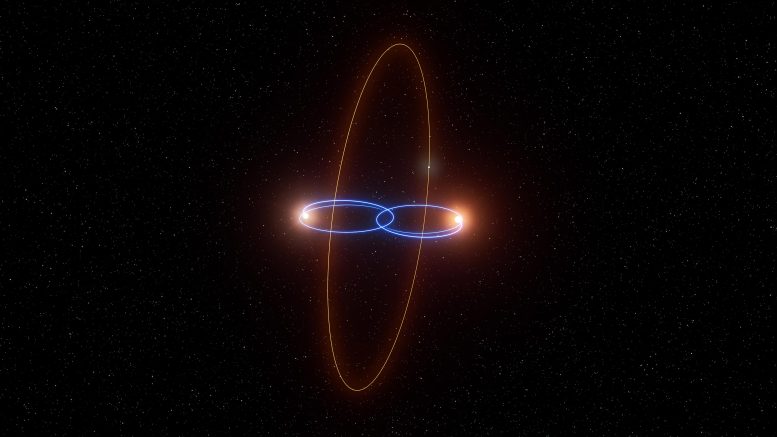
Posted on 04/18/2025 6:36:49 AM PDT by Red Badger

A strange new planet has been found circling two stars at a right angle — like something out of sci-fi. It’s the first solid evidence of a so-called polar orbit around a binary system. Credit: SciTechDaily.com
***************************************************************************
Astronomers using ESO’s Very Large Telescope have discovered a truly bizarre planet — one that orbits two stars at a perfect 90-degree angle.
This “polar planet” circles a rare eclipsing pair of brown dwarfs, making it the first confirmed world with this kind of alignment. It was a surprising and accidental find, defying expectations and proving that planet formation in extreme orbital setups is not only possible — it’s real.
Hints of Polar Planets Come to Life
In recent years, scientists have found several planets orbiting two stars at once — similar to the fictional planet Tatooine from Star Wars. Typically, these planets orbit in the same plane as the stars themselves. While researchers have long suspected that planets could also form in perpendicular, or polar, orbits around binary stars — and have even observed planet-forming discs tilted this way — there had been no direct evidence of a planet on such an orbit until now.

Planet Perpendicular Orbit Around Two Brown Dwarfs
This is an artist’s impression of the exoplanet 2M1510 (AB) b’s unusual orbit around its host stars, a pair of brown dwarfs. The newly discovered planet has a polar orbit, which is perpendicular to the plane in which the two stars are traveling. Credit: ESO/L. Calçada
****************************************************************************
Confirming the Unexpected
“I am particularly excited to be involved in detecting credible evidence that this configuration exists,” says Thomas Baycroft, a PhD student at the University of Birmingham, UK, who led the study published today (April 16) in Science Advances.
The unprecedented exoplanet, named 2M1510 (AB) b, orbits a pair of young brown dwarfs — objects bigger than gas-giant planets but too small to be proper stars. The two brown dwarfs produce eclipses of one another as seen from Earth, making them part of what astronomers call an eclipsing binary. This system is incredibly rare: it is only the second pair of eclipsing brown dwarfs known to date, and it contains the first exoplanet ever found on a path at right angles to the orbit of its two host stars.
VIDEO AT LINK................
Using ESO’s Very Large Telescope (VLT), astronomers have found an exoplanet orbiting a pair of peculiar stars at an angle of 90 degrees. There have previously been hints that these so-called polar planets around two stars could exist, but we now have clear evidence that this is the case. This special system was found by observing the orbital path of the two stars being pushed and pulled in a way that could only be explained by the presence of a planet on a polar orbit. This video summarizes the discovery, explaining the nature of these peculiar stars and the method astronomers used to find this odd planet. Credit: ESO
A Planet Unlike Any Other
“A planet orbiting not just a binary, but a binary brown dwarf, as well as being on a polar orbit is rather incredible and exciting,” says co-author Amaury Triaud, a professor at the University of Birmingham.
The team found this planet while refining the orbital and physical parameters of the two brown dwarfs by collecting observations with the Ultraviolet and Visual Echelle Spectrograph (UVES) instrument on ESO’s VLT at Paranal Observatory, Chile. The pair of brown dwarfs, known as 2M1510, were first detected in 2018 by Triaud and others with the Search for habitable Planets EClipsing ULtra-cOOl Stars (SPECULOOS), another Paranal facility.

2M1510 A
This image, taken in visible light, shows 2M1510 AB, a pair of brown dwarfs orbiting each other. The two brown dwarfs, A and B, are seen as a single source in this image, but we know there are two of them because they periodically eclipse each other. When monitoring their orbits, astronomers found perturbations that can only be explained by the gravitational tug of an exoplanet circling both brown dwarfs in a perpendicular orbit. This system contains a third brown dwarf, 2M1510 C, which is located too far away to be responsible for these perturbations. Credit: DESI Legacy Survey/D. Lang (Perimeter Institute)
*****************************************************************
The Puzzle Behind the Orbit
The astronomers observed the orbital path of the two stars in 2M1510 being pushed and pulled in unusual ways, leading them to infer the existence of an exoplanet with its strange orbital angle. “We reviewed all possible scenarios, and the only one consistent with the data is if a planet is on a polar orbit about this binary,” says Baycroft.[1]
“The discovery was serendipitous, in the sense that our observations were not collected to seek such a planet, or orbital configuration. As such, it is a big surprise,” says Triaud. “Overall, I think this shows to us astronomers, but also to the public at large, what is possible in the fascinating Universe we inhabit.”

Exoplanet Around Two Brown Dwarfs
This illustration shows an exoplanet orbiting around two brown dwarfs – objects bigger than gas-giant planets but too small to be proper stars. Credit: ESO/M. Kornmesser
**************************************************************************
Notes
In the new Science Advances study, 2M1510 or 2M1510 AB are the names given to the eclipsing binary of two brown dwarfs, 2M1510 A and 2M1510 B. The same system is known to have a third star, orbiting at large distance from the pair, which the study authors call 2M1510 C. The study shows this third star is too far away to cause the orbital disturbances.
Reference:
“Evidence for a polar circumbinary exoplanet orbiting a pair of eclipsing brown dwarfs”
16 April 2025, Science Advances.
DOI: 10.1126/sciadv.adu0627
The team is composed of:
T. A. Baycroft (University of Birmingham, Birmingham, United Kingdom), L. Sairam (University of Birmingham, Birmingham, United Kingdom; University of Cambridge, Cambridge, United Kingdom), A. H. M. J. Triaud (University of Birmingham, Birmingham, United Kingdom), and A. C. M. Correia (Universidade de Coimbra, Coimbra, Portugal; Observatoire de Paris, Université PSL, France).
This is an animation of the exoplanet 2M1510 (AB) b’s unusual orbit around its host stars, a pair of brown dwarfs. The newly discovered planet has a polar orbit, which is perpendicular to the plane in which the two stars are traveling. Credit: ESO/L. Calçada
This animation shows an exoplanet orbiting around two brown dwarfs – objects bigger than gas-giant planets but too small to be proper stars. The motion seen here is due to the camera and doesn’t reflect the actual orbital motion of the planet around the stars. Credit: ESO/M. Kornmesser
Ping!......................
Just give us back Pluto and let us get on with our fleeting lives. ;)
Unless there’s a link to Uranus, I’m not interested!
Ewwwwwwwww! 🤔
Will they name it Tatooine ?LOL
Interesting.
I’m always amused by these detailed conjectures about planets outside our solar system.
Do you know how astronomers know they exist? The star exhibits a periodic “dimming” while the planet transits the face of it. That’s it.
Is this a story about astronomy, or the cast of the live-action remake of "Snow White"?
More Science Fiction for you.
That’s only one method. It is also the one that has detected the most exoplanets because the Kepler telescope uses it. There is also the Doppler method which was mainly used before Kepler, and measures the star’s wobble due to the exoplanet’s gravitational tug on the star as it orbits. The latest method is to just observe them directly, which they’ve been doing more and more as technology allows.
I'm wondering if the above illustration Planet Perpendicular Orbit Around Two Brown Dwarfs is actually a cosmic illustration of Dilbert Creator Scott Adams.
Sounds like a reat place to ship all the domestic insane communists....
Waaaayyy better than an asylum where we’d have to pay to guard, feed and clothe em.
Fascinating….

I bet the tides are a sight to behold!!
God is Great!
It makes sense. As the two stars oscillate away from the mean center of the ellipse, they correct any chance for the orbiting satellite to drift out of the perpendicular too far. So I would imagine you would see a wobble (or tilting back and fourth) measured greatest at the apogee of the ellipse, but the swing is always back or corrected to the mean.
Disclaimer: Opinions posted on Free Republic are those of the individual posters and do not necessarily represent the opinion of Free Republic or its management. All materials posted herein are protected by copyright law and the exemption for fair use of copyrighted works.